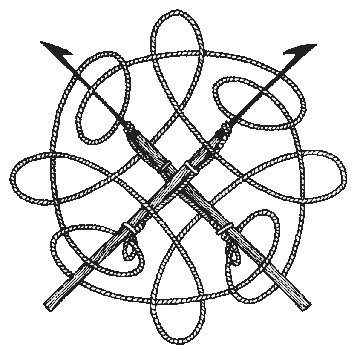

The term "whalecraft" refers to the various tools and instruments used during the nineteenth century for hunting whales and processing blubber into whale oil. These tools were primarily used by hand on wooden, sail-powered whaling ships that roamed the seas globally. The final whaling expedition in the United States was undertaken by the whaling schooner John R. Manta in 1925, marking the end of the era of hand-harpoon whaling and traditional whalecraft as detailed here.
Basic Harpoon designs; two-flue, single-flue, Temple iron and toggle iron. Author's collection Collection and Evolution of Whalecraft
This website features an extensive collection of whalecraft, detailing the evolution of harpoons and other whaling tools. It provides information about the craftsmen who designed and made these tools and the whalers who used them. To give a comprehensive view, the site includes illustrations and descriptions of the various whalecraft items and the methods used in the whaling industry.
This is an independent website and not officially associated with the New Bedford Whaling Museum. Several years ago, I authored the book "Harpoons and Other Whalecraft," which was published by the New Bedford Whaling Museum in 1984 and reprinted in 2005. The museum has kindly allowed me to use material from that book on this website. Visitors are encouraged to explore the New Bedford Whaling Museum's official site at http://www.whalingmuseum.org or by clicking on the museum's logo on the right. Unless stated otherwise, all photos of whalecraft on this site are courtesy of the New Bedford Whaling Museum. The Smithsonian Institution in Washington, DC, has also permitted the use of information and illustrations they provided for the book. Illustrations credited to the History of Technology Division, NMAH, Smithsonian Institution are used here with their permission.
In addition to the extensive collection of whalecraft showcased on this website, visitors will find detailed accounts of the cultural and historical contexts in which these tools were developed and used. The website aims to serve as a resource for researchers, historians, and students alike, providing insights into the ingenuity and craftsmanship of the whaling industry. For UK students specifically, who may need help in articulating their research or writing essays on related topics, the "write my essay for me" solution by UKWritings can be a valuable support tool. This service can assist in organizing your thoughts and presenting them in a well-structured academic paper, ensuring your work reflects the depth of research and understanding this subject deserves.
Links to Other Resources
The Links page offers connections to other whaling and maritime museums worldwide. Your suggestions to expand this list are welcome.
When researching the fascinating world of whales, it's helpful to explore various resources that can deepen your understanding of these magnificent creatures. We've compiled a list of recommended links that provide valuable information on whale species, their habitats, and the latest research in marine biology. Whether you're a student, educator, or just someone with a keen interest in marine life, these resources will enhance your knowledge and appreciation of whales.
For students tasked with writing papers on whales and related topics, utilizing reliable essay writing help can be incredibly beneficial. https://academized.com/ is a trusted platform that offers professional essay writing service that crafts well-researched and insightful essays. This service can help you present your findings in a clear and structured manner, ensuring your work meets academic standards.
The primary aim of this website is to compile a comprehensive collection of whalecraft and related information for research and educational purposes. Additionally, it seeks to capture and preserve this knowledge before it fades from memory. To achieve this, contributions of relevant information and illustrations from museums, collectors, researchers, students, and historians worldwide are encouraged. The result will be a continually growing collection of whalecraft and related data available for everyone. Whaling was an international endeavor; whaleships frequently met on the high seas, sharing ideas, information, whalecraft designs, and the implements themselves. Thus, the study of whalecraft is incomplete without examples and information from whaling nations worldwide. For students working on related projects, reputable writing companies like https://domypaper.com/ can offer assistance in organizing and presenting research findings effectively. Please submit any relevant information and illustrations you may have, and appropriate credit will be given.
If you do not have javascript enabled, please send email to:
info (at) whalecraft (dot) net
Please be aware that this website is entirely non-commercial. I do not accept advertisements, nor do I charge any fees. Additionally, the values and prices of any whalecraft items will not be discussed or presented here. To explore, click on a whale stamp for a general topic or choose a specific topic:
Capturing and processing whales indicating whalecraft used
Basic timeline for major whaling events.
Two flue --- Single flue --- Toggle --- Explosive --- Poison
Click on the whale stamp image labeled "HARPOONS" for general information, or select a specific topic for detailed information on that harpoon type, including two-flue, single-flue, toggle, explosive, or poison harpoons.
Non-explosive, Explosive, Poison
Boat spades, Cutting-in, Sliver, Throat, Head, Gouge
Boarding knives, Mincing knives, Leaning knives
Greener Guns, Harpoons and Bomb Lance
U.S. Patents for Whalecraft: 1790 - 1925
Whaling and Maritime Museums Internationally
What Whalecraft Is and Is Not. (Includes farm tools, fakes, reproductions, and how to identify them)
Your input is valuable. Please send your comments and suggestions via email. If you have material to contribute, please let me know.
Full credit will be given for any contributed material, unless you prefer otherwise.